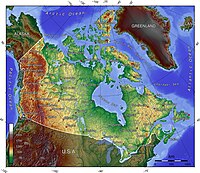Geography of Canada

Canada is a very big country located in the northern part of North America. It is the second largest country in the world (just after Russia) and is made up of ten provinces and three territories.
Canada has borders with the United States to the south and with the Arctic Ocean to the north. It has a long coastline on the Pacific, Atlantic, and Arctic oceans.
The geography of Canada is very diverse, meaning it has many different landscapes. Canada has mountains (like the Rocky Mountains and the Appalachians), forests (like the boreal forests and the rainforests of the west coast), prairies (like the grasslands in Alberta and Saskatchewan), and vast expanses of tundra and arctic landscapes.
Canada is also home to many lakes and rivers, including the Great Lakes (which share a border with the United States) and the Mackenzie River (which is the longest river in Canada).
Because Canada is so big, it also has many different climates and weather patterns. Some parts of Canada are very cold (like the Arctic) and others are quite warm (like British Columbia). In some areas, there is a lot of rain and in others, it is very dry.
In Canada, people have adapted to different geographies by living in different types of houses (like igloos in the Arctic or log cabins in the forests) and by using different types of transportation (like skidoos in the snow or canoes on the rivers).
Overall, the geography of Canada is very interesting and diverse, and it has shaped the way people live and interact with their environment in many different ways.
Canada has borders with the United States to the south and with the Arctic Ocean to the north. It has a long coastline on the Pacific, Atlantic, and Arctic oceans.
The geography of Canada is very diverse, meaning it has many different landscapes. Canada has mountains (like the Rocky Mountains and the Appalachians), forests (like the boreal forests and the rainforests of the west coast), prairies (like the grasslands in Alberta and Saskatchewan), and vast expanses of tundra and arctic landscapes.
Canada is also home to many lakes and rivers, including the Great Lakes (which share a border with the United States) and the Mackenzie River (which is the longest river in Canada).
Because Canada is so big, it also has many different climates and weather patterns. Some parts of Canada are very cold (like the Arctic) and others are quite warm (like British Columbia). In some areas, there is a lot of rain and in others, it is very dry.
In Canada, people have adapted to different geographies by living in different types of houses (like igloos in the Arctic or log cabins in the forests) and by using different types of transportation (like skidoos in the snow or canoes on the rivers).
Overall, the geography of Canada is very interesting and diverse, and it has shaped the way people live and interact with their environment in many different ways.
Related topics others have asked about:
Geography of British Columbia,
Geography of Alberta,
Geography of Saskatchewan,
Geography of Manitoba,
Geography of Ontario,
Geography of Quebec,
Geography of New Brunswick,
Geography of Prince Edward Island,
Geography of Nova Scotia,
Geography of Newfoundland and Labrador,
Geography of Yukon,
Geography of Northwest Territories
